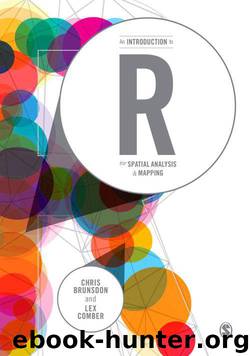An Introduction to R for Spatial Analysis and Mapping by Brunsdon Chris & Comber Lex

Author:Brunsdon, Chris & Comber, Lex [Brunsdon, Chris]
Language: eng
Format: epub
ISBN: 9781473911192
Publisher: SAGE Publications
Published: 2015-01-21T22:00:00+00:00
where is an estimate of the intensity – given by
with |A| being the area of a study region defined by a polygon A. Also I(.) is an indicator function taking the value 1 if the logical expression in the brackets is true, and 0 otherwise. To consider whether this sample comes from a clustered or dispersed process, it is helpful to compare to KCSR(d).
Statistical inference is important here. Even if the dataset had been generated by a CSR process, an estimate of the K-function would be subject to sampling variation, and could not be expected to match KCSR(d) perfectly. Thus, it is necessary to test whether the sampled is sufficiently unusual with respect to the distribution of estimates one might expect to see under CSR to provide evidence that the generating process for the sample is not CSR. The idea is illustrated in Figure 6.9. Here, 100 K-function estimates (based on equation (6.5)) from random CSR samples of 100 points (the same number of points as in Figure 6.8) are are superimposed, together with the estimate from the point set shown in Figure 6.8. From this it can be seen that the estimate from the clustered sample is quite different from the range of estimates expected from CSR.
Another aspect of sampling inference for K-functions is the dependency of on the shape of the study area. The theoretical form KCSR(d) = λπd2 is based on assumption of points occurring in an infinite two-dimensional plane. The fact that a ‘real-world’ sample will be taken from a finite study area (denoted here by A) will lead to further deviation of sample-based estimates of from the theoretical form. This can also be seen in Figure 6.9 – although for the lower values of d the CSR estimated K-function curves resemble the quadratic shape expected, the curves ‘flatten out’ for higher values of d. This is due to the fact that for larger values of d, points will only be observed in the intersection of a circle of radius d around a random xi and the study area A. This will result in fewer points being observed than the theoretical K-function would predict. This effect continues, and when d is sufficiently large any circle centred on one of the points will encompass the entirety of A. At this point, any further increase in d will result in no change in the number of points contained in the circle – this provides an explanation of the flattening-out effect seen in the figure.
Download
This site does not store any files on its server. We only index and link to content provided by other sites. Please contact the content providers to delete copyright contents if any and email us, we'll remove relevant links or contents immediately.
| Biomathematics | Differential Equations |
| Game Theory | Graph Theory |
| Linear Programming | Probability & Statistics |
| Statistics | Stochastic Modeling |
| Vector Analysis |
Weapons of Math Destruction by Cathy O'Neil(5032)
Factfulness: Ten Reasons We're Wrong About the World – and Why Things Are Better Than You Think by Hans Rosling(4016)
Factfulness_Ten Reasons We're Wrong About the World_and Why Things Are Better Than You Think by Hans Rosling(2751)
Descartes' Error by Antonio Damasio(2728)
A Mind For Numbers: How to Excel at Math and Science (Even If You Flunked Algebra) by Barbara Oakley(2690)
TCP IP by Todd Lammle(2633)
Applied Predictive Modeling by Max Kuhn & Kjell Johnson(2475)
Fooled by Randomness: The Hidden Role of Chance in Life and in the Markets by Nassim Nicholas Taleb(2408)
The Book of Numbers by Peter Bentley(2400)
The Tyranny of Metrics by Jerry Z. Muller(2399)
The Great Unknown by Marcus du Sautoy(2180)
Once Upon an Algorithm by Martin Erwig(2143)
Easy Algebra Step-by-Step by Sandra Luna McCune(2111)
Practical Guide To Principal Component Methods in R (Multivariate Analysis Book 2) by Alboukadel Kassambara(2089)
Lady Luck by Kristen Ashley(2067)
Police Exams Prep 2018-2019 by Kaplan Test Prep(2028)
Linear Time-Invariant Systems, Behaviors and Modules by Ulrich Oberst & Martin Scheicher & Ingrid Scheicher(1980)
All Things Reconsidered by Bill Thompson III(1957)
Secrets of Creation, Volume 1: The Mystery of the Prime Numbers by Watkins Matthew(1858)
